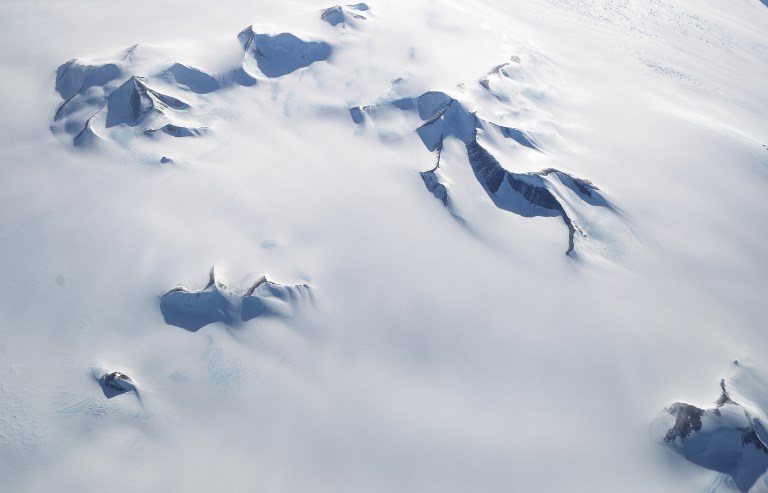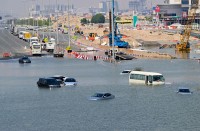
by Marlowe HOOD
Agence France Presse
PARIS, France (AFP) — As global warming outpaces efforts to tame it, scientists have proposed building massive underwater structures to prevent an Antarctic glacier the size of Britain from sliding into the sea and lifting the world’s oceans by several meters.
The more modest of two engineering schemes — which is still on the scale of a Panama or Suez Canal — to shore up Thwaites Glacier would require the construction of Eiffel Tower-sized columns resting on the seabed to support the glacier’s ocean-facing edge, or ice shelf.
Option Two is a 100-meter tall underwater wall, or berm, running 80-100 kilometers (55-60 miles) beneath the ice shelf to block bottom-flowing warm water that erodes the glacier’s underbelly, rendering it unstable.
The ambitious projects, detailed Thursday in the European Geophysical Union journal The Cryosphere, reflect a gathering awareness that slashing planet-warming greenhouse gas emissions — while essential — may not happen quickly enough to avoid catastrophic climate change impacts.
“Thwaites could easily trigger a runaway ice sheet collapse that would ultimately raise global sea levels by about three meters,” said lead author Michael Wolovick, a researcher at Princeton University’s Geophysical Fluid Dynamics Laboratory.
Nor will reducing carbon pollution be enough: any credible pathway to a world in which global warming is capped below two degrees Celsius above pre-industrial levels (3.6 degree Celsius) — the target enshrined in the 2015 Paris climate treaty — depends on sucking large quantities of CO2 out of the air.
As a result, geoengineering schemes once dismissed as impractical, unnecessary or outright dangerous — injecting particles into space to deflect the sun, storing CO2 in the ground, planting millions of square kilometres in biofuels — have rapidly moved from the margins toward the centre of scientific and policy discussion.
But none of these schemes address sea level rise, which is likely to cause more human misery than any other climate impact: by century’s end, it could swamp dozens of island states and densely populated river deltas, especially in Asia and Africa.
Runaway collapse
“The scientific community should carefully investigate the possibility of glacial geoengineering,” said Wolovick. “There are hundreds of millions of people who live within a few metres of sea level.”
Until recently, sea level rise was caused mainly by ocean water expanding under the influence of global warming. Today, the biggest driver is run off from ice sheets sitting atop the island of Greenland and the continent of Antarctica.
Taken together, Greenland and West Antarctica — more vulnerable to global warming than East Antarctica — contain enough frozen water to lift the ocean watermark by about 12 metres.
For Thwaites, there is an added sense of urgency.
“It may already have passed the tipping point, we won’t know for sure for a decade or two,” said co-author John Moore, chief scientist at the College of Global Change and Earth System Science at Beijing Normal University.
“But the acceleration starts slowly, so we will have a century or so to prevent runaway collapse.”
Wolovick and Moore ran computer models to test their geoengineering schemes, taking into account the known variables influencing glacier-ocean dynamics.
The underwater towers — which could be built with material dredged from the continental shelf or quarried from exposed rock — stood a 30 percent change of significantly slowing the glacier’s disintegration.
Initially sceptical
“We show that it is possible to stabilize glacier beds by providing extra pinning points they can use to support themselves,” said Moore.
Building a berm to block the warm water eating at Thwaites’ underside doubled the odds of success, but would likely carry a price tag in the hundreds of billions of dollars, they found.
“It is nowhere near ready for implementation, and the potential side effects require much more research”, Wolovick said.
The goal of the study, he added, was mostly to spark a conversation among scientists.
“Initially, I was very Skeptical,” said Moore. “But compared with the alternatives, the idea certainly deserves to be much better researched and investigated.”
The researchers also emphasized that geoengineering solutions do not lessen the need for reducing humanity’s output of greenhouse gases, which hit record levels in 2017.
“There are dishonest elements of society that will try to use our research to argue against the necessity of reducing emissions,” said Wolovick. “Our research does not in any way support that interpretation.”
“The more carbon we emit, the less likely it becomes that the ice sheets will survive in the long term.”
© Agence France-Presse







